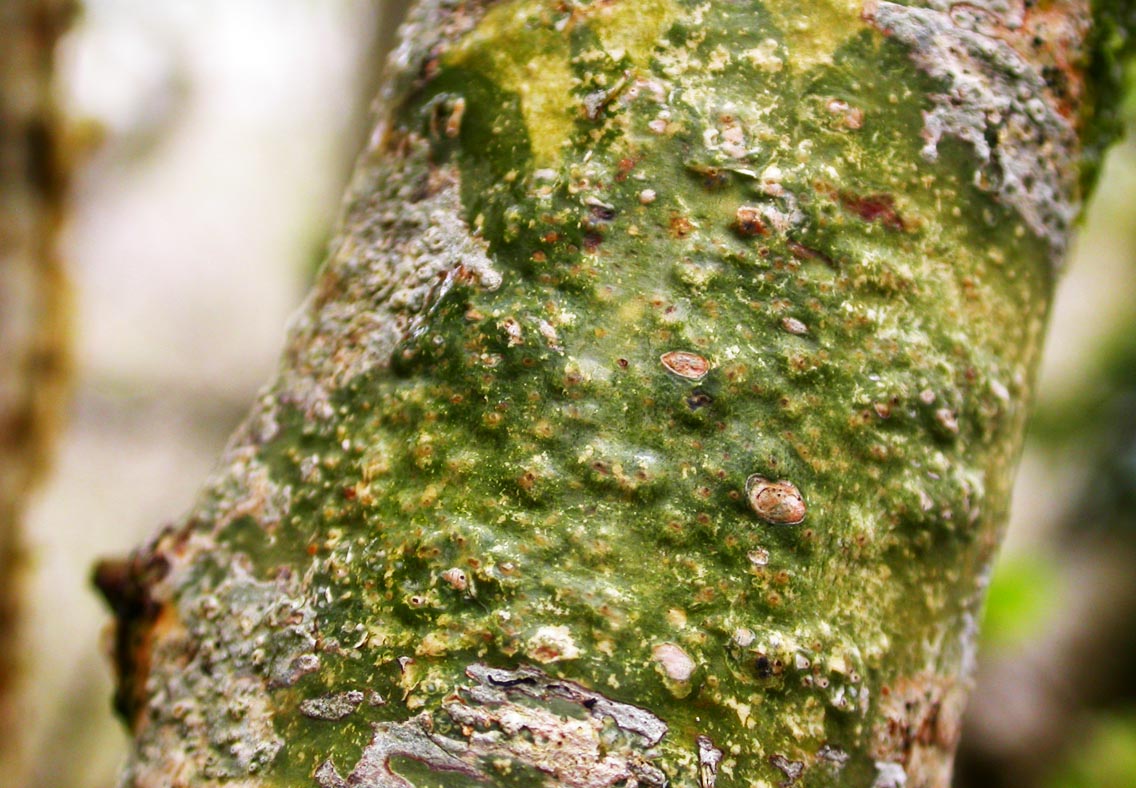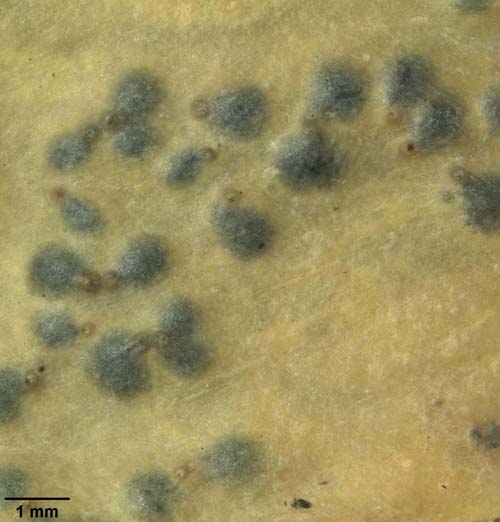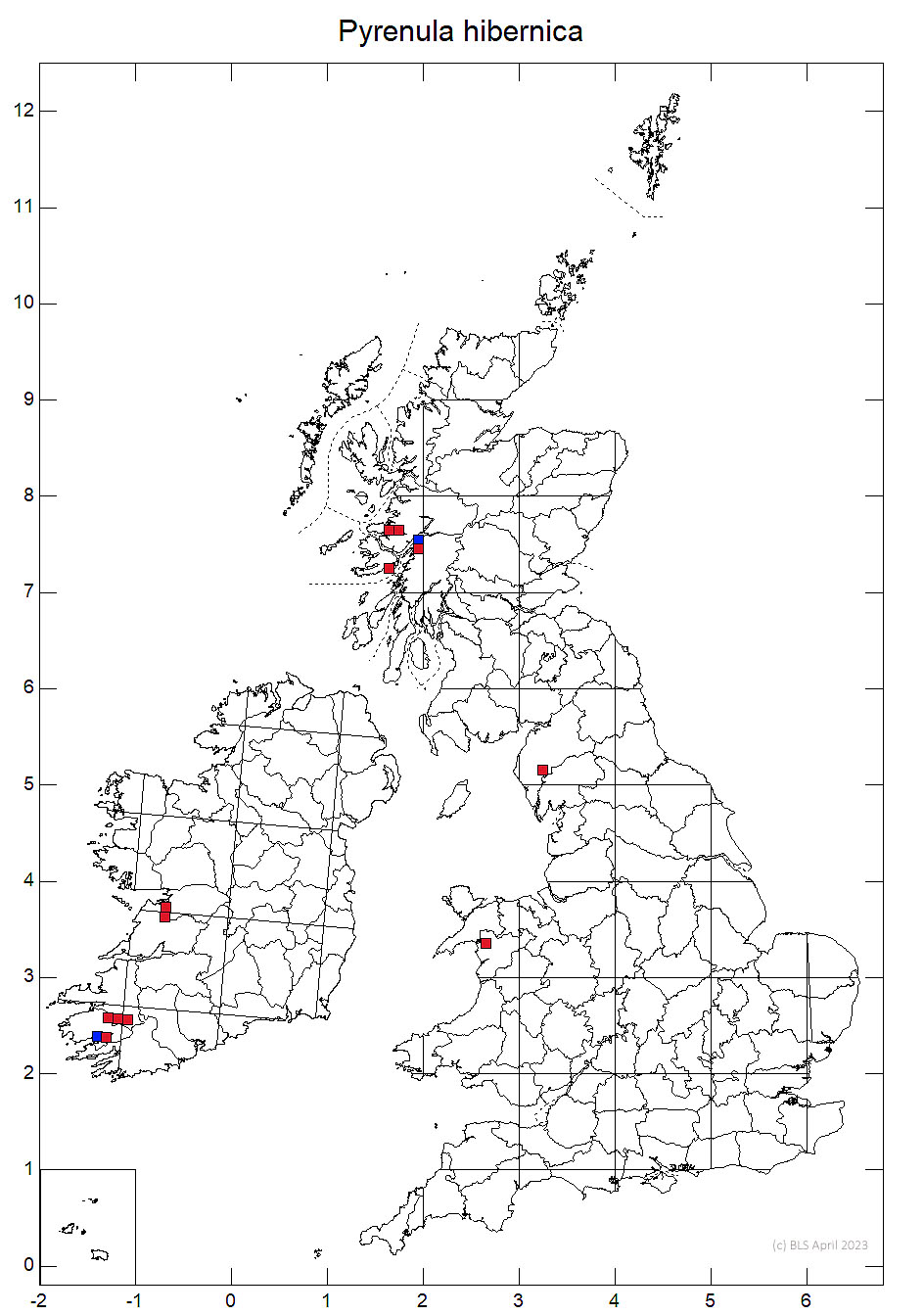Pyrenula chilensis (Fee) R.C. Harris
Parmentaria chilensis Fee
Blackberries in custard
 |
 |
| Photo: Ray Woods | Photo: Alan Orange |
A member the Graphidion, a community of lichens confined to smooth bark, its pale olive-green or yellow-buff immersed thallus is often barely perceptable to the untrained eye on the somewhat similar coloured bark of old hazel trunks. Occasionally small white dots are present. Immersed in the thallus are clusters of black perithecia (each perithecium 1 to 1.2mm in diam) that if visible give the lichen its English name of blackberries and custard as the perithecia grow in blackberry-like clusters and the thallus can be yellowish like custard. Unfortunately, as with the Welsh population, the perithecia are often almost invisible from the surface. No other large crustose lichen has such clusters of perithecia with the ostiole through which the spores are dicharged offset to one side. Unlike all other Pyrenula species the spores in this species are muriform.
This lichen is confined to the most least disturbed, very sheltered, humid woodland. It has been recorded only on hazel trunks in Wales but elsewhere in the British Isles it is also known on the smooth bark of holly. The following link takes you to an excellent paper on the importance and management of oceanic hazelwoods by Brian and Sandy Coppins. They argue that coppicing is a destructive form of management and lichen-rich hazel woods may never have suffered this form of management. Rather stems were selectively removed from within each bush, creating small openings in the canopy. These gaps would be quickly filled by the growth of new shoots so providing new smooth bark for colonisation by Graphidion lichens growing in close proximity on adjacent uncut stems within the same hazel bush. http://www.treesforlife.org.uk/tfl.hazel_scottish.html
Pyrenula hibernica in the Burren, Ireland is mostly confined to old hazel clumps on cliff ledges. It is also more frequent on the side of the hazel closest to the cliff. It is tempting to speculate that this niche avoids as much frost as possible, the cliff acting as a natural storage heater and the position well up the slope avoids night time temperature inversions. It is interesting that Neil Sanderson's description of the sole Welsh site fits a similar pattern of a rock ledge well above the valley floor for a species found mostly in climates warmer than Wales.
It was first discovered in Wales in 2005 by Neil Sanderson whilst undertaking a survey of the Ceunant Llennyrch Special Area of Conservation near Trawsfynydd, Meirionydd (see Sanderson (2006) for details). It was recorded on 14 hazel bushes in some quantity on a difficult to access sloping ledge above the main ravine but still within the gorge. It was associated with a number of other species new to Wales in a particularly important and internationally scarce community of hyperoceanic lichens of smooth bark. Two further hazel bushes with colonies of blackberries and custard were located nearby in a somewhat more accessible area.
This internationally rare species is elsewhere known from three sites in the West Highlands of Scotland, from a few sites in Kerry, Killarney and the Burren in Ireland and from the Azores and the western Pyrenees where in this latter site it is known on hazel and box in the Gorge de Kakouetta (Serusiaux pers comm).
Current ownership and management of the single Welsh site needs to be established and long term conservation measures put in place.
Adjoining areas of woodland should be managed to encourage its spread.
Coppins, A. M. (2006) Lichens. British Wildlife. 17: 136-138.
Sanderson,N. (2006). Pyrenula hibernica at Ceunant Llennyrch, Meirionnydd. Bulletin of the British Lichen Society, Spring 2006, 23-27.
- Log in to post comments

